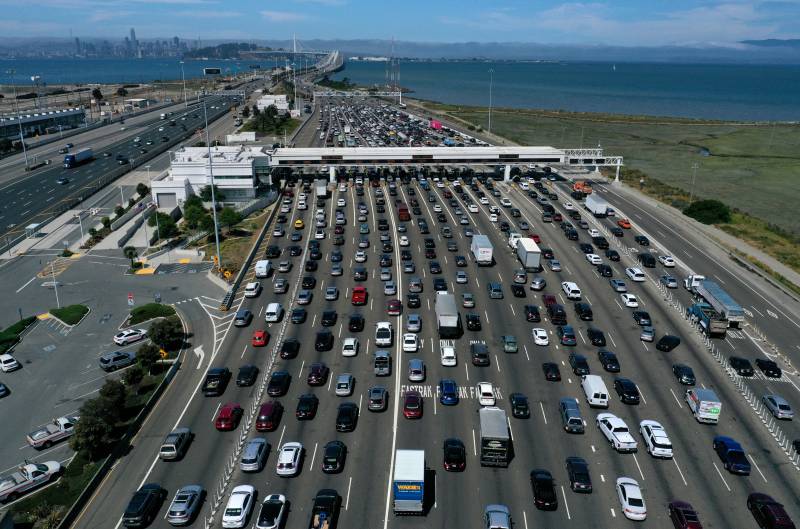So far, looks like they were right.
By last fall, car traffic in California had rebounded to roughly 90% of where it had been pre-pandemic, and national studies show that truck traffic went up along with the delivery of food, groceries and goods, Shilling says.
“In the depths of the pandemic and the traffic reduction, people were obviously hoarding,” he said. “They stocked up and then they didn’t need to make as many trips, and we had a huge reduction in overall traffic.”
But people adjusted, and while there is less traffic than before the pandemic, “we’ve got more of that goods and services delivery going on, and we may even have an increase in pollution and greenhouse gas emissions,” Shilling said.
Last year, emissions declined by nearly 13% in the U.S. and about 7% globally, the largest annual drop in global energy-related carbon dioxide emissions since World War II.
The reduction was driven largely by a sharp drop in vehicle traffic during the first half of the year in the early stage of lockdowns, according to an estimate by the international Carbon Monitor program.
Shilling maintains that if the amount of driving eliminated during the pandemic could be duplicated, it would put California, at least, on track to reach some of its climate goals, not to mention lead to an improvement in air quality.
But that steep curb in global warming emissions started to reverse during the second half of the year, when economic activity began to recover. Global emissions were 2% higher in December 2020 than in the same month a year earlier, according to the International Energy Agency, an intergovernmental energy analysis and policy group.
“A lot of people were hurt and died” during the pandemic, said Shilling, whose son had COVID-19. “It affects everybody. What can we get out of it? Learning. A society that doesn’t learn is just going to repeat all of those mistakes.”
Transportation-related emissions, at nearly 50% of California’s total overall, are the top source of greenhouse gas emissions in the state. That’s despite decades of policies meant to reduce pollution from tailpipes.
Last summer, in the wake of wildfires driven by extreme heat, Gov. Gavin Newsom ordered California to halt the sale of new gasoline-powered cars by 2035, in an effort to accelerate the state’s reduction of greenhouse gases.
The mass adoption of electric vehicles will surely be needed if California is going to transition from fossil fuels. But studies have shown that in order to meet ambitious climate goals, people will also need to drive less during the many years it will take for gas vehicles to disappear from the state’s roads.
Kate Gordon, the governor’s top climate adviser, argued Californians should embrace tele-everything in the fight against climate change, using the internet to reduce driving.
Some technology companies are allowing employees to work from home permanently. But many businesses are just now beginning to grapple with what work life could look like after restrictions to prevent the spread of COVID-19 are lifted.
Remote work offered some white-collar workers a chance to live in less crowded cities and towns, with cheaper rents and lower taxes. But people living in the country or in the suburbs drive a lot more —to work, but also to the grocery store and to visit friends.
The Bay Area Council recently released a study showing that 1.79 million jobs, or 45% of the region’s workforce, could be performed from home, a higher proportion than in Los Angeles and other areas of the state.
“If each of the region’s 1.79 million people employed in a remote eligible job worked outside of the office for just one day per week, over 1 million single-occupancy vehicle trips could be avoided each week — a reduction of 8% based on pre-COVID-19 travel,” the report’s authors wrote.
Should California make a push to increase remote work, issues of equity could emerge. The state suffers from a vast digital divide, with high-speed internet access available in many of the busiest city centers, but not in remote areas in the Central Valley, Inland Empire, and northern part of the state. Also, remote work capability rises as along with pay. Prior to the pandemic, 51% of the Bay Area’s white workforce, which has a higher average income, were employed in potential work-from-home occupations, compared to only 33% of the Black and 30% of the Latinx workforce.
Which experiments in telecommuting will be maintained on a widespread basis is still unknown. Partly because a year after the state first issued a shelter-in-place order, life has changed for a substantial number of people. Where exactly they will live, commute, and work when the pandemic subsides has not come into focus yet.
Last fall, planners at the Metropolitan Transportation Commission debated a measure requiring workers at Bay Area companies with more than 25 employees to work three days a week from home. But Silicon Valley businesses and Bay Area mayors pushed back on the plan, arguing the requirement for employers was too strict, and could decimate public transit ridership, the Mercury News reported.
The group developed a compromise plan that would require larger companies to ensure that 60% of their employees commute using mass transit, bikes or carpools by the year 2035.
If adopted, the policy would ask employers to take responsibility for the congestion, air quality, and climate change impacts of their employees as they go to and from work.

